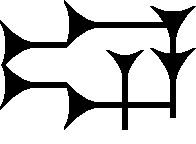KÁ

The cuneiform sign KÁ, for gate is the sumerogram-(logogram) used in the Amarna letters and the Epic of Gilgamesh; as just KÁ it means "gate" or "doorway", Akkadian language, "bābu"; as "Gate-Great", KÁ.GAL for City-Gate, it is from Akkadian "abullu", ("(city) gate"). Both uses are in the Epic of Gilgamesh.[1] In the Epic, it is only used as the sumerogram, a total of 19 times, (7 times for 'abullu', city gate).[2] In the Epic, all spellings for city gate use KÁ.GAL; for gate ('bābu') only one spelling uses the alphabetic letters for b-a-b-u; the rest use KÁ along with other added cuneiform signs (KÁ-x-x, or KÁ-x, etc.).
Amarna letters
In the Amarna letters, the topic of Amarna letter EA 296, Under the Yoke, is the guarding of two cities, at the city gate; also the man authoring the letter, Yabitiri-(Yahtiru)-(governor?) of City? is called a "gatekeeper", lines 24 and 31: LÚ.PA.KÁ.ŠU, Man-Gate-"hand". Šu (cuneiform), (shaped like a 'hand'), has the secondary meaning besides šu, for Akkadian language qat, for "qātu", 'hand' (as ŠU, a sumerogram), and used for 9 of about 15 spellings of 'qātu' in the Epic of Gilgamesh.[3]
In letter EA 296, the text is as follows: (reverse side of letter)[4]
- "...inquire of his commissioner whether I guard the city gate of Azzatu, and the city gate of Yapu, ...."
The city gate is also discussed in the Amarna letter from Tjaru.
See also
References
- ↑ Parpola, 197l. The Standard Babylonian Epic of Gilgamesh, Glossary, pp. 119-145, bābu, p. 122; abullu, p. 119.
- ↑ Parpola, 197l. The Standard Babylonian Epic of Gilgamesh, Sign List, pp. 155-165, no. 133, p. 158.
- ↑ Parpola, 197l. The Standard Babylonian Epic of Gilgamesh, Glossary, pp. 119-145, qātu, p. 137.
- ↑ Moran, 1987, 1992. The Amarna Letters,, EA 296, Under the Yoke, pp. 338-9.
- Moran, William L. 1987, 1992. The Amarna Letters. Johns Hopkins University Press, 1987, 1992. 393 pages.(softcover, ISBN 0-8018-6715-0)
- Parpola, 197l. The Standard Babylonian Epic of Gilgamesh, Parpola, Simo, Neo-Assyrian Text Corpus Project, c 1997, Tablet I thru Tablet XII, Index of Names, Sign List, and Glossary-(pp. 119–145), 165 pages.
|
|
